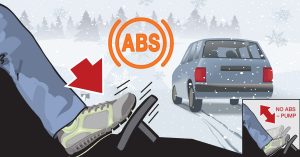 Anti-lock Braking Systems (ABS) are most effective when in good contact with the road and applied promptly and firmly. They have been fitted as standard in cars since the 1980s to help prevent skidding. In emergency situations, drivers tend to slam on the brakes. In a car without an ABS, this causes the car to skid when the wheel locks and the driver loses control of the steering. However, using sensors on the wheels, an ABS can detect when a wheel is beginning to lock. When it detects wheel lock, the ABS takes over and reduces how much braking takes place on the locking wheel or wheels. This helps to maintain traction on the road and steering control, allowing you to stop safely sooner.
Anti-lock Braking Systems (ABS) are most effective when in good contact with the road and applied promptly and firmly. They have been fitted as standard in cars since the 1980s to help prevent skidding. In emergency situations, drivers tend to slam on the brakes. In a car without an ABS, this causes the car to skid when the wheel locks and the driver loses control of the steering. However, using sensors on the wheels, an ABS can detect when a wheel is beginning to lock. When it detects wheel lock, the ABS takes over and reduces how much braking takes place on the locking wheel or wheels. This helps to maintain traction on the road and steering control, allowing you to stop safely sooner.
How can you brake safely with an ABS installed?
Prior to the invention of the ABS, car users were encouraged to pump the brakes rather than apply their foot to the brake firmly. However, when driving a car with an ABS fitted, it is important to apply your foot firmly to the brake as soon as you can and until you reach a stop. You do not have to worry about wheel lock as the ABS will ensure this does not happen. However, if you are driving on an uneven or loose surface, you should reduce your speed accordingly as ABS brakes are not as effective when in poor contact with the road.
Theory Test Question
Have you had a go at answering the theory test question: When are anti-lock brakes (ABS) most effective? Let’s take each answer in turn and check your knowledge of this question.
When you brake normally but grip the steering wheel tightly
Wrong! Gripping the wheel tightly will not improve the effectiveness of an ABS. However, it is important to maintain a good grip on the steering wheel when braking.
When you keep pumping the foot brake to prevent skidding
Wrong! This braking method is only suitable for vehicles not fitted with an ABS.
When you brake promptly and firmly until you’ve stopped
Correct! A car fitted with an ABS works best when you apply your foot firmly to the brake as quickly as possible and until you reach a complete standstill.
When you apply the handbrake to reduce the stopping distance
Wrong! Applying the handbrake at speed is dangerous and could cause you to skid and lose control of the vehicle.
References
It is stated in section 5 of the official DVSA guide to driving that:
If your vehicle is fitted with ABS brakes, the system activates automatically under conditions of harsh braking.
ABS employs wheel-speed sensors to anticipate when a wheel is about to lock under extreme braking. Just before the wheels begin to lock, the system releases the brakes momentarily before automatically reapplying them. This cycle is repeated several times a second to maximise braking performance, sending a pulsing sensation through the brake pedal. You may find this a little disconcerting the first time it occurs and you may be tempted to respond by relaxing the pressure on the brake pedal. However, it’s important that maximum pressure is maintained.
ABS doesn’t necessarily reduce your stopping distance, but because the wheels are prevented from locking you can continue to steer – something you wouldn’t be able to do if the wheels were locked. Reducing the pressure or pumping the brake pedal reduces the effectiveness of the system. The pressure on the brake pedal must be maintained until the hazard is safely avoided.
Knowing ABS will help you stop safely shouldn’t encourage you to drive less carefully. ABS can’t overcome the laws of physics; it’s still possible for one or more of the tyres to skid because of
- poor road contact
- surface water
- a loose road surface.
Highway Code rule 120 states:















